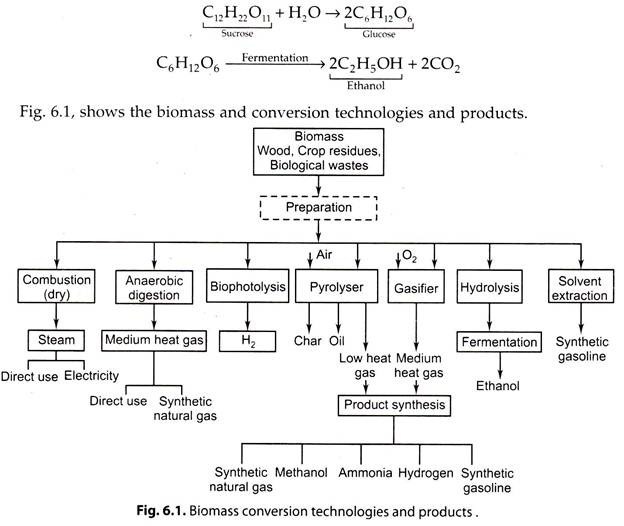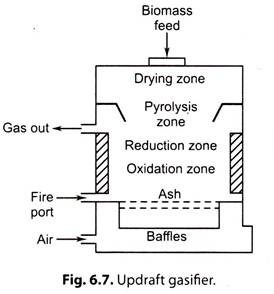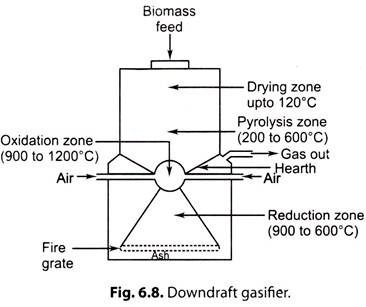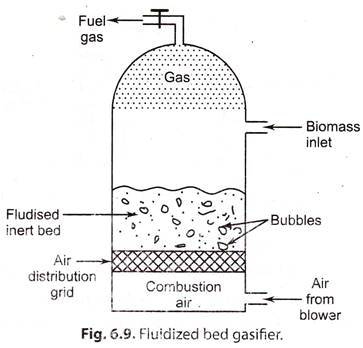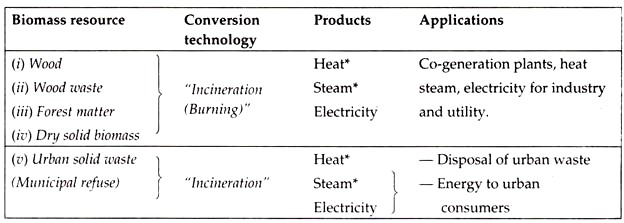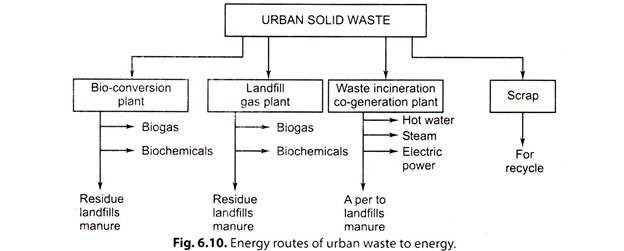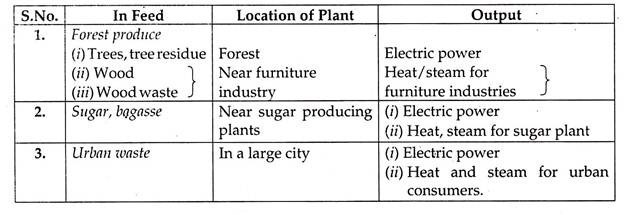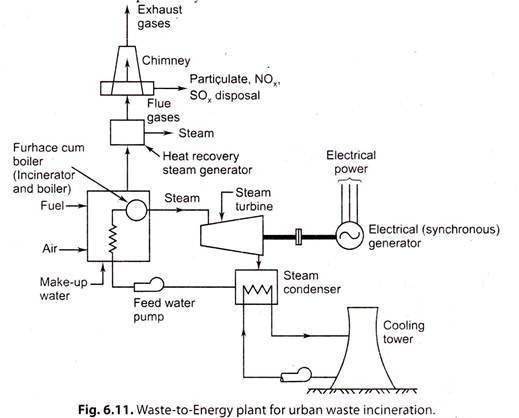Are you looking for an essay on ‘Biomass’? Find paragraphs, long and short essays on ‘Biomass’ especially written for school and college students.
Essay on Biomass
Essay Contents:
- Essay on the Introduction to Biomass
- Essay on Biomass Resources
- Essay on the Availability of Biomass
- Essay on the Limitations of Utilising Biomass
- Essay on the Environmental Effects of Biomass
- Essay on the Methods to Obtain Energy from Biomass
- Essay on the Process Used for Biomass Conversion to Energy
- Essay on the Classification of Biomass Gasifiers
- Essay on the Conversion Technology of Biomass
- Essay on the Energy Plantation Using Biomass
Essay #
1. Introduction to Biomass:
Biomass is an organic matter from plants, animals and micro-organisms grown on land and water and their derivatives. The energy obtained from biomass is called biomass energy.
“Biomass” is considered as a renewable source of energy because the organic matter is generated everyday.
Coal, petroleum, oil and natural gas do not come in the category of ‘biomass’, because they are produced from dead, buried biomass under pressure and temperature during millions of years.
i. “Biomass” can also be considered a form of solar energy as the latter is used indirectly to grow these plants by photosynthesis.
ii. “Biomass fuel” is used over 85 percent of rural households and in about 15 percent urban dwellings. Agriculture products rich in starch and sugar like wheat, maize, sugarcane can be fermented to produce ethanol (C2H.OH). Methanol (CH3OH) is also produced by distillation of biomass that contains cellulose like wood and begasse. Both these alcohols can be used to fuel vehicles and can he mixed with ‘diesel’ to make biodiesel.
Essay #
2. Biomass Resources:
In our country, there is a great potential for application of biomass as an ‘alternate source of energy’. We have plenty of agricultural and forest resources for reproduction of biomass.
The following are the biomass resources:
1. Concentrated Wastes:
(i) Municipal solid
(ii) Sewage wood products
(iii) Industrial waste
(iv) Manure at large lots.
2. Dispersed Waste Residue:
(i) Crop residue
(ii) Logging residue
(iii) Disposed manure.
3. Harvested Biomass:
(i) Standing biomass
(ii) Biomass energy plantations.
The biomass sources are highly dispersed and bulky and contain large amount of water (50 to 90%). Thus, it is not economical to transport them over long distances, and as such conversion into usable energy must take place close to the source, which is limited to particular regions. However, biomass can be converted to liquid or gaseous fuels, thereby increasing its energy density and making transportation feasible over long distances.
Essay #
3. Availability of Biomass:
a. The total terrestrial crop alone is about 2 x 1012 metric tonnes.
This includes:
(i) Sugar crops such as sugarcane and sweet sorghum;
(ii) Herbaceous crops, which are non- woody plants that are easily converted into liquid or gaseous fuels; and
(iii) Sihiriculture (forestry) plants such as cultured hybrid poplar, sycamore, sweatgum, alder, eucalyptus, and other hardwoods.
b. The terrestrial crops have energy potential of 3 x 1022 joules. The efficiency of solar energy utilisation in natural photosynthesis is only 0.1 to 2 percent. At present only 1 percent of world biomass is used for energy conversion.
Current research focuses on the screening and identification of species that are suitable for short-rotation growing and on optimum techniques for planting, fertilization, harvesting, and conversion. Fast growing trees, sugar, starch and oil containing plants can be cultivated which have about 5 percent efficiency of solar energy utilisation.
c. The estimated production of agricultural residue in India is 200 million tonnes per year and that of wood is 130 million tonnes.
d. Aquatic crops are grown in fresh sea and brackish waters, both submerged and emergent plants. These include seaweeds, marine algae etc.
e. Animal and human wastes are an indirect terrestrial crop from which methane for combustion, and ethylene can be produced while retaining the fertilizer value of the manure. The daily produce of cowdung is about 13.5 kg per cattle which can be used to produce 0.46 m3 of biogas in ‘Gobar gas plant’. This gas is sufficient to produce 1 kWh of electricity in a biogas engine.
The human waste can also be used for production of biogas. Community latrines can be planned in the villages for collection of night soil for feeding to biogas plants. Wastes of 200 persons can be used to produce about 5 m3 of gas per day to extract 12 kWh of equivalent energy by running a biogas engine.
Essay #
4. Limitations of Utilising Biomass:
Following are the limitations of utilising biomass:
1. Relatively expensive energy conversion.
2. Low conversion efficiency (i.e. small percentage of sun light is converted to biomass by plants).
3. Relatively low concentration of biomass per unit area of land and water.
Essay #
5. Environmental Effects of Biomass:
Following are the effects of biomass:
1. Biomass can pollute air when it is burned but less than those of fossil fuels.
2. Biomass, when burned, does not release green-house gases (or CC2).
3. Burning biofuels do not produce pollutants like sulphur that results in acid rain.
4. When biomass crops are grown, nearly equivalent amount of CO2 is captured through photosynthesis.
Essay #
6. Methods to Obtain Energy from Biomass:
Energy from biomass can be obtained by using the following methods:
1. Combustion;
2. Anaerobic digestion;
3. Pyrolysis;
4. Hydrolysis and ethanol fermentation;
5. Gasifier.
1. Combustion:
‘Combustion’ is the process, now in commercial operation, that uses biomass to produce energy. Direct combustion requires biomass with a moisture content around 15% or less, so it may require drying prior to combustion for most of the crops.
2. Anaerobic Digestion:
The biogas plants using anaerobic digestion are simple in construction with low capital outlay.
The anaerobic digestion process has the following advantages:
(i) It utilises biomass with high percentage of water.
(ii) Small units are available, which can be operated as individual farms.
(iii) The residue has fertilizer value.
The major “limitation” with this process is that large quantity of waste water is to be disposed of after digestion.
3. Pyrolysis:
‘Pyrolysis’ is an irreversible change brought about by the action of heat in the absence of oxygen; the energy splits the chemical bonds and leaves the energy stored in biomass. It may yield either solid, liquid or gaseous fuel.
Advantages:
(i) Compactness;
(ii) Simple equipment;
(iii) Low pressure operation;
(iv) High conversion efficiency of the order of 83 percent
(v) Negligible waste product.
4. Hydrolysis and Ethanol Fermentation:
The process of hydrolysis converts cellulose to alcohols through fermentation. Ethyl alcohol can be produced from variety of sugar by fermentation with yeasts.
5. Gasifier:
Pyrolysis-gasification is a promising conversion technology. It appears to be economically competitive with natural gas, using biomass wastes.
Essay #
7. Process Used for Biomass Conversion to Energy:
The following processes are used for the biomass conversion to energy or to biofuels:
a. Densification.
b. Combustion and incineration.
c. Thermo-chemical conversion.
d. Biochemical conversion.
a. Densification:
In this process bulky biomass is reduced to a better volume-to-weight ratio by compressing in a die at a high temperature and pressure. The biomass pressed into briquettes or pellets (easier to transport and store) can be used as clean fuel in domestic chulhas, bakeries and hotels.
b. Combustion and Incineration:
Combustion:
Combustion is the process of burning in presence of oxygen to produce heat (utilised for cooking, space heating, industrial purposes and for electricity generation), light and byproducts.
The combustion of biomass is more difficult than other fuels since it contains relatively higher moisture content. Biomass is free from toxic metals and its ash.
This method is very inefficient with heat losses to 30 to 90% of the original energy contained in the biomass.
The technology of “fluidised bed combustion” may be used for the efficient combustion of forestry and agricultural waste material such as sawdust, wood chips, hog fuel, rice husks, straws, nutshells and chips.
In fluidised bed combustion of biomass, the biomass is fed into a bed of hot inert particles, such as sand kept in fluidised state with air at sufficient velocity from below. The operating temperature is normally controlled within the range 750- 950°C; ideally it is kept as high as possible in order to maximise the rate of combustion and heat transfer but low enough to avoid the problem of sintering of the bed particles. The rapid mixing and turbulence within the fluidised bed enables efficient combustion to be achieved with high heat releases, as well as effective transfer, than in a conventional boiler. This can result in more compact boiler with less number of tubes.
Incineration:
It is the process of burning completely the solid masses to ‘ashes by high temperature oxidation.
Although the terms ‘combustion’ and ‘incineration’ are synonymous, yet the “combustion process” is applicable to all fuels (i.e., solid, liquids and gases); “incineration” is a special process which is used for incinerating municipal solid waste to reduce the volume of solid refuse (90 per cent) and to produce heat steam and electricity.
Pyrolysis:
Wood, dung, vegetable waste can be dried and burnt to provide heat or converted into low calorific value by pyrolysis. In the pyrolysis process, the organic material is converted to gases, solids and liquids by heating to 500 to 900°C in the absence of oxygen.
c. Thermo-Chemical Conversion:
It is a process to decompose biomass with various combinations of temperatures and pressures.
Thermo-chemical conversion takes the following two forms:
(i) Gasification;
(ii) Liquification.
(i) Gasification:
It is the process of heating the biomass with limited oxygen to produce ‘low heating value’ or by reacting it with steam and oxygen at high pressure and temperature to produce ‘medium heating value gas’.
The output gas is known as “producer gas”, a mixture of H2 (15-20%), CO (10 to 20%), CH4 (1 to 5%), CO2 (9 to 12%) and N2 (45 to 55%). As compared to solid mass the gas is more versatile, it can be burnt to produce heat and steam, or used in I.C. engines or gas turbines to generate electricity.
(ii) Liquification:
a. Biomass can be liquified through fast or flash pyrolysis, called “pyrolytic oil” which is a dark brown liquid of low viscosity and a mixture of hydrocarbons.
b. Biomass can also be liquified by “methanol synthesis”. Gasification of biomass produces synthetic gas containing a mixture of H2 and CO. The gas is purified by adjusting the composition of H2 and CO. Finally, the purified gas is subjected to liquefication process, converted to methanol over a zinc, chromium catalyst.
Methanol can be used as liquid fuel.
d. Biochemical Conversion:
In biochemical conversion there are two principal conversion processes:
i. Anaerobic digestion;
ii. Fermentation.
(i) Anaerobic Digestion:
This process involves ‘microbial digestion’ of biomass and is done in the ‘absence of oxygen’.
The process and end products depend upon the micro-organisms cultivated under culture conditions. (An anaerobe is a microscopic organism that can live and grow without external oxygen or air; it extracts oxygen by decomposing the biomass at low temperatures upto 65°C, in presence of moisture).
This process generates mostly methane (CH4) and CO2 gas with small impurities such as hydrogen sulphide. The output gas obtained from anaerobic digestion can be directly burnt, or upgraded to superior fuel gas (methane) by removal of CO2 and other impurities. The residue may consist of protein-rich sludge and liquid effluents which can be used as animal feed or for soil treatment after certain processing.
Aerobic decomposition is done in the presence of oxygen and it produces CO, NH3 and some other gases in small quantities and large quantity of heat. The final by-product of this process can be used as fertilizer. (ii) Fermentation:
Fermentation is the process of decomposition of organic matter by micro-organisms especially bacteria and yeasts.
i. It is a well-established and widely used technology for the conversion of grains and sugar crops into ethanol (ethyl alcohol).
ii. Ethanol can be blended with gasoline (petrol) to produce gasohol (90% petrol and 10% ethanol). Processes have been developed to produce various fuels from various types of fermentations.
Essay #
8. Classification of Biomass Gasifiers:
Biomass gasifiers may be classified as follows:
A. According to the “Type of Bed”:
1. Fixed Bed Gasifiers:
(i) Updraft,
(ii) Downdraft, and
(iii) Crossdraft
Depending upon the direction of airflow.
B. According to the “Output Power”:
(i) Small size gasifiers – Output upto 10 kW.
(ii) Medium size gasifiers – Output in the range of 10 kW to 50 kW.
(iii) Large size gasifiers – Output in the range of 50 kW to 300 kW. and
(iv) Very large gasifiers – Output of 300 kW and above.
1. Fixed Bed Gasifiers:
(i) Updraft (or Counter Current) Gasifier: (Refer to Fig. 6.7)
In such a gasifier (where fuel and air move in counter current manner) air enters below the combustion zone and the ‘producer gas’ leaves near the top of the gasifier. The gas produced contains tar and water vapour and the ash content is almost nil.
These gasifiers are suitable for stationary engines (which use tar free fuels like charcoal).
(ii) Downdraft (or Cocurrent) Gasifier. Refer to Fig. 6.8.:
In downdraft gasifier (where fuel and air move in a cocurrent manner, air enters at the combustion zone and the gas produced leaves near the bottom of the gasifier.
i. Fuel (biomass) is loaded in the reactor from the top. As the fuel moves down it is subjected to drying (120°C) and pyrolysis (200-600°C) where solid char, acetic acid, methanol and water vapour are produced.
ii. Descending volatiles and char reach the oxidation zone (900 to 1200°C) where air is injected to complete the combustion.
iii. The products moving downwards, enter the reduction zone (900 to 600°C), (reaction being endothermic) where ‘producer gas’ is formed by the action of C02 and water vapour on red hot charcoal. The producer gas contains products like CO, H2 and CH4; it is purified by passing it through coolers, tar is removed by condensation, whereas soot and ash are removed by centrifugal separation.
The downdraft gasifier is most commonly used for “engine applications” because of its ability to produce a relatively clean gas.
Fixed bed gasifiers can attain efficiency upto 75 percent for conversion of solid biomass to gaseous fuel.
(iii) Crossdraft Gasifiers:
In this type of gasifier, the gas produced passes upwards in the annular space around the gasifier that is filled with charcoal. The charcoal acts as an insulator and a dust filter.
These gasifiers are suitable for power generation upto 50 kW; however, these do not find much application.
2. Fluidised Bed Gasifiers:
A fluidised bed gasifier is most versatile and any biomass, including sewage sludge pulping effluents etc., can be gasified by using this type of gasifier. (Refer to Fig. 6.9.)
Fluidised Bed Combustion (FBC) constitutes a hot bed of inert solid particles of sand or crushed refractory supported on a fine mesh or grid. An upward air current fludizes the bed material.
The pressurised air starts bubbling through the bed and the particles attain a stage of high turbulence, and the bed exhibits fluid like properties. A uniform temperature within the range of 750 to 950°C is maintained so that the ash zones do not get heated to its initial deformation temperature and this prevents clinkering or slagging.
i. In the fluidised bed, a large surface is created and the constantly changing area per unit volume provides a higher conversion efficiency at low operating temperatures, compared to fixed beds.
Low grade fuels of even non-uniform size and high moisture content can be gasified by the high heating capacity of sand and uniform temperature of fluidized bed.
ii. To put the gasifier in use the bed material is heated to ignition temperature of the fuel and biomass is then injected causing rapid oxidation and gasification. The fuel gas thus obtained is conditioned and cleaned for utilisation as an engine fuel.
Advantages of Fluidised Bed Gasifier:
1. High heat storage capacity.
2. Simple operation.
3. Compact size.
4. Consistent combustion rate.
5. High output rate.
6. Quick startup.
7. Fuel flexibility.
8. High moisture content fuel can be used.
9. Uniform temperature throughout the finance volume.
10. Reduced emission of nitrogen oxides.
Essay #
9. Conversion Technology of Biomass:
The “Urban Waste” is disposed off suitably by “Waste-to-Energy” conversion systems including:
1. Landfill Gas Energy Plants.
2. Waste Incineration Cogeneration Plants.
3. Biochemical Conversion Plants.
One of the most important biomass conversion technologies is Incineration (Combustion).
The applications of “Incineration process” are given below:
In cold countries heat is supplied by the utilities for heating the houses. Steam is required for process industries.
Following are the other processes of “waste-to-energy” and “wood-to-energy”:
1. Production of biomass from waste, by methane formation process,
2. Production of wood gas from wood,
3. Production of biogas from landfills, etc.
Urban Solid Waste (Municipal Waste, Municipal Refuse):
The domestic waste (Refuse) in the cities is usually sent to landfill sites located far away from the centre of the city. Large cities like Delhi, Bombay have large amount of waste and increasing waste disposal problems. The emerging solution is to produce useful thermal and electrical energy by waste-to-energy plants (WTE) located in the heart of city.
Such energy plants are rated in MW (50 to 500 MWe) and serve the following functions:
1. Safe and economical disposal of urban waste.
2. Supply of electrical and thermal energy to the consumers in the city.
3. Environmental protection from urban waste.
Fig. 6.10. shows the energy routes of urban waste to energy.
Waste-to-Energy Incineration Process:
The energy route of the waste-to-electrical energy by incineration process is given below:
The “incineration process” accepts a wide variety of biomass inputs including:
1. Semi-dried wood, trees, tree residues, wood chips, saw-dust.
2. Semi-dried garbage (urban waste).
3. Semi-dried farm waste (dried cow-dung, straw, sugar, bagasse, etc.).
4. Mixtures of fossil fuels and biomass for higher heat content of the infeed.
5. Steam is supplied to steam-turbine power plant (50 to 150 MW).
6. Heat (hot water) is supplied for district heating in cold countries.
7. Steam is supplied to process industry.
“Waste incineration power plant” is usually located near the source of waste. Table below gives the locations of “Waste-to-Power Plants”:
Waste Incineration Energy Plant:
The schematic diagram of ‘Waste-to-Energy plant’ for urban waste incineration is shown in Fig. 6.11 which is self-explanatory.
Processing of Wood and Wood-Waste (Fuel) for Feeding to the Incineration Plant:
The incineration plant is usually located in the forest and near saw mill. This reduces the expenditure of transportation of wood and makes it competitive as a fuel for producing electricity.
The various steps involved in the process are:
(i) Felling of trees in the forest.
(ii) Segregating logs, tree barks, leaves etc.
(iii) Transporting the logs and other residue to central store.
(iv) Storing the logs in a circular store.
(v) Drying of wood in the circular store.
(vi) Collecting dried wood by means of central crane in the circular store and transporting the wood to power plant for incineration.
(vii) Shredding (making smaller pieces).
(viii) Feeding to the furnace.
Essay # 10. Energy Plantation Using Biomass:
When land plants are grown purposely for their fuel value, by capturing solar radiation in is called Energy plantation. ‘Energy plantations’ by design are managed and operated to provide substantial amounts of unusable fuel continuously throughout the year at the costs competitive with other fuels. Annual plants, typical of important farm crops, are unsuitable for providing a year-around supply of fuel.
Biomass energy concepts under study are resulting in the cultivation of large forests in areas not suitable for food production. Energy plantation may yield 10 to 20 tonnes per acre per year. The energy plantation would be perhaps 125-500 m2 in land area. The trees are to be harvested by automated means, then chipped and pulverised for burning in a power plant that would be located in the middle of the energy plantation.
The properties of plants to be cultivated in India are given in table 6.3.
i. Some schemes envision ‘aquatic farms’ growing algae, tropical grasses, floating kelp, water hyacinth and others. These could yield several hundred tonnes/acre year in controlled environments.
ii. An interesting idea may be to use hot condenser cooling water from a power plant to grow algae in large quantities or increase the yield of other crops.
iii. Fast growing trees, sugar, starch and oil containing plants can also be cultivated for bio-energy.
Advantages of Energy Plantation:
1. No storage losses vis-a-vis harnessing solar energy (Plants, as they grow, serve as their own energy accumulator).
2. Wide flexibility, if the crop maturity cycle extends over years.
3. Under optimised conditions, the cost of energy obtained through plantation works out to be lesser than present fossil fuel cost on heat value basis as obtained by direct burning of wood.
4. The problem of SO2 pollution by combustion of biomass is practically nil.
5. The ash obtained after burning vegetable matter is rich in plant nutrient-minerals, unlike ash of fossil fuels, and can be used as a manure.
6. Energy plantation will convert large tracks of semi-barren land into green belt and thus ecological conditions can be restored.
7. Growth of biomass consumes CO2 as much (as produced by consumption of biomass, and as such the atmosphere is not polluted. Combustion of fossil fuel releases CO2 in very large amounts and also they consume huge amounts of O2 from the atmosphere).
